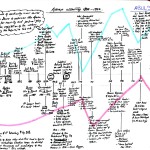 As we have now written on both industry and the condition of the workers it felt appropriate to conclude by comparing the two. Below therefore are your three attempts to draw two timelines on the same page (blue is industrial progress and pink is level of suffering for the workers), followed by your written justifications of your ideas.
As we have now written on both industry and the condition of the workers it felt appropriate to conclude by comparing the two. Below therefore are your three attempts to draw two timelines on the same page (blue is industrial progress and pink is level of suffering for the workers), followed by your written justifications of your ideas.
Remember the higher the position on the timeline the greater the industrial activity / level of suffering. The key here of course is to look at relative positions within and across timelines.
Task – Study your peers’ timeline and comments. Post a reply. What do you agree and disagree with ? Make sure to explain your thoughts using evidence (that you interact with ?).
Mr Kydd.
The Girls


Why we drew the industry line where we did
We started our line low for the reason that the Crimean war was the 1st instance showing how much Russian needed to industrialise. After the Emancipation edict, an internal market started to form, hence the reason our line rose. However, we didn’t rank overtly high, due to the fact that it would have only had a long-term effect and would have not been beneficiary for the short-term. We decided ‘The great Spurt’ was one of the first instances where Russia began to industrialise on an international level, leading to a heightening of line. However industrialisation rapidly decreased, plunging lowest in the 1918 treaty of Brest-Litovsk, where Russian lost 25% of its population; 25% of its industry and 80% of its coal industry. During Stalin’s second 5yr plan in 1935, the Russian industry grew to its highest point in the years of 1855-1964 – were the Russian economy was just equipped enough to defend themselves in war. Yet, in 1945 Russia’s industrialisation decreased due to the German invasion of Barbarossa . Ending our line with increase in Russia’s industrialisation due to the fact in the year of 1956 Russia was now publically classed as a super power, wining the space race. Examples of this is Russia’s launching of Sputnik in October 1953 – the first artificial earth satellite, and also the development of the Nuclear Bomb.
Why we drew the exploitation of the workers line where we did
Our view of the relationship between the two lines
The Boys


Why we drew the industry line where we did
From 1860-1890 there was a focus on industrialisation after the realisation of Russia’s backwardness in the Crimean war. The foundations of modernisation were being laid, culminating in Witte’s great spurt, with the highlight being the development of the Trans-Siberian railway which linked Russia’s population to its vast natural resources. However the First World War was further evidence for Russia’s lack of industrialisation, and the devastation of war communism along with the loss of large industrial areas under the treaty of Brest Litovsk led to levels of industrialisation dropping to pre- emancipation levels. Lenin’s NEP introduced a mixed economy that allowed for prosperity. As a result levels of industrialisation rapidly increased to pre-war levels. Russia reached its peak of industrial development under Stalin, as his unprecedented production output made Russia strong enough to defend herself from German invasion in the Great Patriotic War. Stalin transformed Russia from an agrarian country into a major industrial superpower. The Great Patriotic War had devastating effects on Russia including the loss of 36 million of her people. However the destruction was not as devastating industrially as that of the First World War due to the levels of industrialisation Stalin had achieved pre-war. When Khrushchev came to power in 1956 Russia was a major industrial superpower and was winning the space race. This was unquantifiable progress from the Russia that just 100 years previous had been humiliated in the Crimean War.
Why we drew the exploitation of the workers line where we did
With the lack of industrialisation pre 1855 most of the suffering occurred in agriculture and although there was exploitation of the serfs, everyone was at the same level. The graph starts so low because this early suffering was nothing in comparison to the suffering that occurred later. Under Vyshnegradskii’s policy of “export and go hungry” the amount of suffering increased, particularly in the 1891 famines. However post Witte, leading into war communism, there was a steady rise in suffering which runs parallel to the First World War. The reason for the sharp increase in suffering under War Communism, peaking in 1920-21 was due to the famines which led to the deaths of an estimated 15 million people. Under the NEP, private trade was once again allowed and peasants could once again sell their surplus crops for profit. This led to food production levels reaching pre-war levels once again. Acton calls this the “golden age” of the Russian peasant. From then on however we see the unique exploitation of the workers under Stalin. This is why the line increases rapidly until it reaches the greatest amount of suffering in the period in 1945. The Soviet Union had been devastated in the Great Patriotic War, 36 million citizens had dies and 70,000 kolkhozy had been completely wiped out. The amount of suffering then begins to decline under Khrushchev. Khrushchev did ease some of the suffering of the workers through his Virgin Lands policy and the focus of consumer goods which led to an increase in standards of living and a decline in suffering.
Our view of the relationship between the two lines
The main relationship between our two lines is that when industrialisation in Russia was increasing, so was the amount of suffering the workers experienced. This is shown by Witte’s Great Spurt in which Russia saw its first big industrial growth and made it the 5th largest industrial country in the world, but at the same time saw the suffering of the workers got worse and lead to the famine of 1891. As well as under Stalin’s five year plans when his unique amount of exploitation on the Russian workers lead to the biggest amount of industrialisation in the countries history, the amount of suffering for the workers reached its absolute peak , and with the of the Second World War as well, saw the death of 36 million Soviet Citizens. The only real exception to this is when the industrialisation of Russia collapsed during the First World War and because of War Communism, the level of the suffering actually increased, which lead to the famine of 1920-21.
The other relationship between the two lines under the NEP and Krushchev is that when they are industrialising that actually do more to make things better for the working classes. For example, the NEP brought food production back to pre war levels and allowed the peasants to sell their surplus once more. Under Krushchev he increases industrialisation, but not at the expense of the proletariats and the peasants, he introduces a focus on consumer goods and increases living standards, as well as implementing his Virgin Lands policy in the countryside.
Abul
(who decided to make his own stand)


Why I drew my Industry line where I did / why I drew my exploitation of the workers line where I did
(done together)
Wittie and pre-Wittie, although saw for example saw for instances rapid railways construction and increasing exports, the suffering during this period reached a peak under Vyshengradskii’s grain export drives, were is thought to have killed 3 million. In his own words “we must export and go hungry” and go hungry they did. Any obstacle face by the tsars was faced with brutal force for example Lena goldfield massacre thought to have killed 200
Although Lenin came to power and in theory severing was meant to decline via his Sovnarkom decrees, the need to win a war led to the economic policy of war communism. This was a greater peak than Vyshengradskiis as it affected both the peasants and the proletariat and killed a greater number of people.
However the NEP success after war communism should not be underestimated as it is considered as the ‘golden age’. For him first time peasants had surplus grain to sell on. ‘Surplus’ is a key word as it signifies that peasants had more than they needed which is very rare in Russian history. Bu 1925 food production had reached pre-war level.
After Lenin’s death Stalin stated that Russia was “50 to 100 years behind the advanced countries”. He exploited the proletariat to an extent where there was 8 million Zeks in the gulags and whole class of kulaks where wiped out in the process of de-kulakastion. The suffering reached a peak during war famine due to collectivisation where it is thought to have killed 36 million soviets.
After Stalin’s death Khrushchev de-nuances Stalin and quotes that “men feared there shadows” suggesting the unparallel levels of exploitation under Stalin. He put greater emphasise on consumer goods which incentives the peasants to increases productivity; furthermore his virgin lands policy greatly increased the amount of land under cultivation. This helped reduce exploitation.
My view of the relationship between the two lines
Industrialisation can be considered as proportional to exploration. Industrialisation was a strand of continuity and exploitation was a result of the need and want of rapid industrialisation. Under Reutern there was no real exploitation, the desire to industrialise was greater under Wittie and Vyshnegardskii who were intent on fulfilling great state projects e.g. trans-Siberian railway and drawing in foreign investment. The economic policies of Vyshnegradskii resulted famine which killed 3 million showing the proportional nature of exploitation and industrialisation.
Industrialisation was halted during war and greatly declined after it. Russia lost vast amounts of resources land, people and 80% of industry making both the peasants and proletariat suffer. War communism further increased the exploration.
NEP and Khrushchev are unique figures as they increased both industrialisation and standard of living. NEP made a profit motive while Khrushchev incentives people with greater number of consumer goods.
Stalin can also be considered as a unique figure as the levels of industrialisation and exploration was unparallel to any other Russian ruler. In the 1930’s growth rate averaged 12-13% but was hampered by war and Stalin’s policies along with war left 36 million dead and more than 8 million were enslaved in the gulags. The peaks therefore are greatest under Stalin.

















